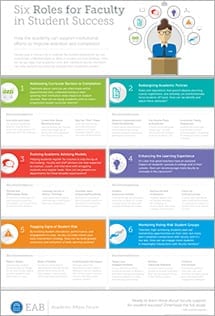The struggle with community colleges and advising centers
In the past, community colleges relied on their advising centers to improve student course-level outcomes. However, the student-advisor ratio at many colleges is over 250:1. This means little time for advisors to directly impact student performance. In response, progressive community colleges have encouraged greater faculty involvement in student success initiatives to alleviate the burden.
Faculty Needed in Student Success Efforts
On the other hand, community colleges cannot expect faculty to assume an advising case load without supplemental support. Most faculty, especially adjunct instructors, balance full course schedules and other administrative duties. Meanwhile, union contracts restrict additional work responsibilities without supplemental compensation.
Early alert systems are just part of the solution
Over the past decade, an increasing percentage of community colleges implemented early alert systems to streamline the intervention process for faculty. Unfortunately, utilization rates for full-time faculty remain stuck around 37%, and 28% for part-time faculty.
Faculty face two key barriers to early alert system usage. First, many perceive the act of flagging students to be too time-intensive of a process. Second, faculty are unaware of the system’s behavioral alerts, or they are unaware of what sort of behavioral risk indicators to flag.
Critical course response campaign
Santa Fe College addressed the first concern over time constraints with their prioritization of early alert usage in critical courses. Santa Fe College implemented an early alert system several years ago; however, administrators noticed that students continued to struggle in key gateway courses.
Instead of waiting for the usual automated reminder at weeks four and eight, the provost and quality enhancement plan director sent a reminder to faculty at week three and seven. This enabled those individuals to submit their early alerts ahead of time.
Santa Fe increased the receptiveness of the alerts by including testimonials from faculty, counselors, and student success coaches. The anecdotes explained how students benefited from the early alerts, while the peer-driven evidence helped overcome skepticism to the usage.
Clarifying behavioral alerts for faculty
Champlain College, meanwhile, addressed the other major barrier: How can we make it easy for faculty to identify who is at risk and who needs academic support? Most courses, whether in-person, online, or hybrid, use a Learning Management System (LMS). Champlain College’s administration looked at the LMS discussion posts in critical courses and identified key words and phrases that identified academic risk. These words included “help,” “tried over and over,” “frustrated,” etc.
Their IT staff automated their LMS system to identify words these words and flag them in reports for faculty. These alerts allowed faculty to quickly intervene with students before they struggle on major examinations or assignments.
How to make strategic goals meaningful for faculty
In addition, Champlain College directed a LMS quality assurance staff to check and see whether certain questions remain unanswered for more than 24 hours, and alerts faculty as necessary.
The faculty’s impact on student success
The amount of time faculty spend with students in the classroom make them valuable partners in any student success initiative. Both Santa Fe College and Champlain College streamlined how their faculty use early alert systems, which resulted in higher completion rates in their gateway courses.
Leveraging faculty to improve student success
Faculty play a large role in your students’ overall academic success. Aside from encouraging earlier intervention for at-risk students, faculty should play a role in creating strategic goals. Even well-meaning faculty are unsure of the agenda which leads to additional barriers in student success initiatives. Executive support and sense of urgency for reform fail to translate to the faculty and staff level, so faculty aren’t sure of their role in student success initiatives. Learn more about how to make strategic goals meaningful for your faculty.
